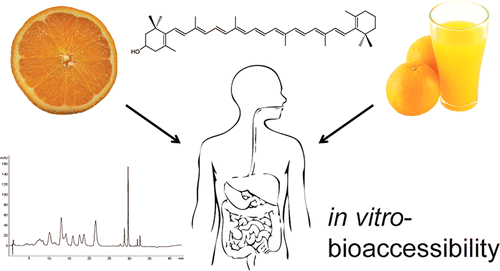Many health advocates advise people to eat an orange and drink water rather than opt for a serving of sugary juice. But in ACS' Journal of Agricultural and Food Chemistry, scientists report that the picture is not clear-cut. Although juice is indeed high in sugar, the scientists found that certain nutrients in orange juice might be easier for the body to absorb than when a person consumes them from unprocessed fruit.
Ralf Schweiggert, Julian Aschoff and colleagues note that oranges are packed with nutrients such as carotenoids and flavonoids that, among other benefits, can potentially help lower a person's risk for certain cancers and cardiovascular disease. But many people prefer to drink a glass of orange juice rather than eat the fruit. Sugar content aside, are they getting the same nutritional benefits? Schweiggert's team set out to answer that question.
The researchers found that the production of pasteurized orange juice slightly lowered the levels of carotenoids and vitamin C. But at the same time, it significantly improved the carotenoid and vitamin C bioaccessibility—or how much the body can absorb and use. And contrary to conventional wisdom, although juicing oranges dramatically cut flavonoid levels, the remaining ones were much more bioaccessible than those in orange segments.
More information: "In Vitro Bioaccessibility of Carotenoids, Flavonoids, and Vitamin C from Differently Processed Oranges and Orange Juices [Citrus sinensis (L.) Osbeck]" J. Agric. Food Chem., 2015, 63 (2), pp 578–587. DOI: 10.1021/jf505297t
Abstract
Carotenoid, flavonoid, and vitamin C concentrations were determined in fresh orange segments and a puree-like homogenate derived thereof, as well as freshly squeezed, flash-pasteurized, and pasteurized juices. Lutein and β-cryptoxanthin were slightly degraded during dejuicing, whereas β-carotene levels were retained. Vitamin C levels remained unaffected, whereas flavonoid levels decreased 8-fold upon juice extraction, most likely due to the removal of flavonoid-rich albedo and juice vesicles. Likewise, the presence of such fibrous matrix compounds during in vitro digestion was assumed to significantly lower the total bioaccessibility (BA) of all carotenoids from fresh fruit segments (12%) as compared to juices (29–30%). Mechanical disruption of orange segments prior to digestion did not alter carotenoid BA, whereas pasteurization of the freshly squeezed juice slightly increased BA by 9–11%. In addition to carotenoid BA, the stabilities of hesperidin, narirutin, and vitamin C including dehydroascorbic acid during in vitro digestion were monitored, and applied analytical methods were briefly validated.
Journal information: Journal of Agricultural and Food Chemistry
Provided by American Chemical Society






















